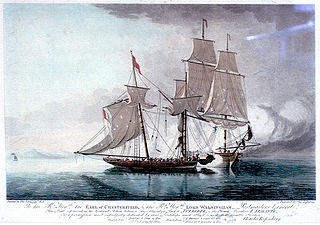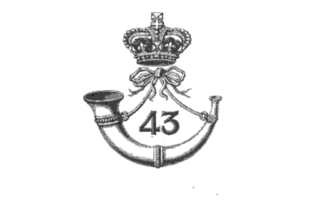Related Research Articles

Admiral of the Fleet Richard Howe, 1st Earl Howe, was a British naval officer. After serving throughout the War of the Austrian Succession, he gained a reputation for his role in amphibious operations against the French coast as part of Britain's policy of naval descents during the Seven Years' War. He also took part, as a naval captain, in the decisive British naval victory at the Battle of Quiberon Bay in November 1759.
Jacques Heath Futrelle was an American journalist and mystery writer. He is best known for writing short detective stories featuring Professor Augustus S. F. X. Van Dusen, also known as "The Thinking Machine" for his use of logic. He died in the sinking of the RMS Titanic.

Antelope was a West Indian packet ship launched in 1780. The French captured her in 1781, 1782, and finally, in 1794. She is most famous for a desperate single-ship action in 1793 when her crew captured a better-armed French privateer with a much larger crew.

The United States Congress authorized the original six frigates of the United States Navy with the Naval Act of 1794 on March 27, 1794, at a total cost of $688,888.82. These ships were built during the formative years of the United States Navy, on the recommendation of designer Joshua Humphreys for a fleet of frigates powerful enough to engage any frigates of the French or British navies yet fast enough to evade any ship of the line.

Benito de Soto Aboal Pontevedra is in Galicia in northern Spain where the language is close to Portuguese, which has confused some sources that say he was Portuguese. He was captain of the pirate ship Defensor de Pedro, sometimes incorrectly named as the Burla Negra, that was responsible for several piracies in the Atlantic in 1828, in a period of increased piracy following the independence of the new states of South America. The most notable attacks were on the British Indiaman Morning Star and the American ship Topaz, which involved great violence. De Soto was captured and tried in Gibraltar on 20 January 1830 and he was hanged on 25 January. Other members of his crew were captured in Spain. Their trial there began on 19 November 1829 and ten men were executed on 11 and 12 January 1830.

John Billington was an Englishman who travelled to the New World on the Mayflower and was one of the signers of the Mayflower Compact.

James Brown Miller, also known as "Killin' Jim", "Killer Miller" and "Deacon Jim", was an American outlaw and title-holder gunfighter of the American Old West, said to have killed 12 people during gunfights. Miller was referred to by some by the alias "Deacon Jim" because he regularly attended the Methodist Church, and he did not smoke or drink. He was lynched in Ada, Oklahoma, in 1909 along with three other men, by a mob of residents angry that he had assassinated a former deputy U.S. marshal.

HMS Babet was a 20-gun sixth-rate post ship of the British Royal Navy. She had previously been a corvette of the French Navy under the name Babet, until her capture in 1794, during the French Revolutionary Wars. She served with the British, capturing several privateers and other vessels, and was at the Battle of Groix. She disappeared in the Caribbean in 1800, presumably having foundered.

Atlantic (1929) is a British drama film directed and produced by Ewald André Dupont and starring Franklin Dyall and Madeleine Carroll. Originally, two versions were made, the English and German-language version Atlantik were shot simultaneously. Subsequently, the production of a French version (Atlantis) began in spring 1930 using different footage and partially an altered storyline. The fourth version was released as a silent film. The story was taken from the West End play The Berg by Ernest Raymond. The film is available online.

The 40th Regiment of Foot was an infantry regiment of the British Army, raised in 1717 in Annapolis Royal, Nova Scotia. Under the Childers Reforms it amalgamated with the 82nd Regiment of Foot to form the Prince of Wales's Volunteers in 1881.

The 43rd (Monmouthshire) Regiment of Foot was an infantry regiment of the British Army, raised in 1741. Under the Childers Reforms it amalgamated with the 52nd (Oxfordshire) Regiment of Foot to form the 1st and 2nd battalions of the Oxfordshire Light Infantry in 1881. The regiment went on to become the Oxfordshire and Buckinghamshire Light Infantry in 1908.

SS Arctic was a 2,856-ton paddle steamer, one of the Collins Line, which operated a transatlantic passenger and mail steamship service during the 1850s. It was the largest of a fleet of four, built with the aid of U.S. government subsidies to challenge the transatlantic supremacy of the British-backed Cunard Line. During its four-year period of service, the ship was renowned both for its speed and for the luxury of its accommodation.

HMS Gladiator was a 44-gun fifth-rate Roebuck-class ship of the Royal Navy. She was launched on 20 January 1783 by Henry Adams of Bucklers Hard. She spent her entire career on harbour service, never putting to sea. Even so, her crew earned prize money for the seizure of two Russian and five American ships. Her sessile existence made her an excellent venue for courts-martial and a number of notable ones took place aboard her. She was broken up in 1817.

Mayflower was an English ship that transported a group of English families, known today as the Pilgrims, from England to the New World in 1620. After a grueling 10 weeks at sea, Mayflower, with 102 passengers and a crew of about 30, reached America, dropping anchor near the tip of Cape Cod, Massachusetts, on November 21 [O.S. November 11], 1620.
William Brown was an American ship that sank in 1841, taking with her 31 passengers. The survivors took to two boats, which later separated to increase their chances of being found. Nine crewmen and 32 passengers occupied the overloaded longboat. At the instigation of the first mate, who was placed in charge by the captain, some of the crew, Alexander Holmes among them, forced 12 of the adult male passengers out of the boat. In the case of United States v. Holmes, Holmes – the only crewman who could be found – was charged with murder and convicted of manslaughter for his actions.

HMS Favourite was a 16-gun Cormorant-class sloop of the Royal Navy, launched in 1794 at Rotherhithe. The French captured her in 1806 and renamed her Favorite. However, the British recaptured her in 1807 and renamed her HMS Goree. She became a prison ship in 1810 and was broken up in Bermuda in 1817.

Emanuel Scrope Howe, 2nd Viscount Howe of Langar Hall, Nottinghamshire was a British politician and colonial administrator.
Saladin was a British barque that made voyages between Britain and the coast of Peru, carrying shipments of guano. The ship is best known for its demise in an act of mutiny, murder and piracy which began with the murder of its captain and officers and ended with the ship being stranded off the coast of Nova Scotia on 21 May 1844, followed by the last major piracy trial in Canada.

SS Arctic, an American paddle steamer owned by the Collins Line, sank on September 27, 1854, 50 miles (80 km) off the coast of Newfoundland after a collision with SS Vesta, a much smaller French vessel. Passenger and crew lists indicate that there were probably more than 400 on board; of these, only 88 survived, most of whom were members of the crew. All the women and children on board perished.
Union was an American sloop built in Somerset, Massachusetts in 1792. It is best known for its circumnavigation of the world, 1794–1796, under the maritime fur trader John Boit.
References
- Sabin, Joseph. Bibliotheca Americana: A Dictionary of Books Relating to America, from Its Discovery to the Present Time'. New York: N. Israel, 1962.
